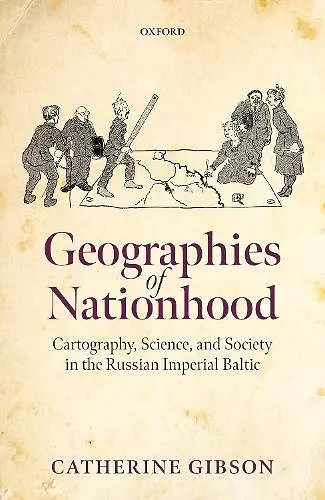Geographies of Nationhood
Cartography, Science, and Society in the Russian Imperial Baltic
Format:Hardback
Publisher:Oxford University Press
Published:31st Mar '22
Currently unavailable, and unfortunately no date known when it will be back

Geographies of Nationhood examines the meteoric rise of ethnographic mapmaking in the nineteenth and early twentieth centuries as a form of visual and material culture that gave expression to territorialised visions of nationhood. In the Russian Empire's Baltic provinces, the development of ethnographic cartography, as part of the broader field of statistical data visualisation, progressively became a tool that lent legitimacy and an experiential dimension to nationalist arguments, as well as a wide range of alternative spatial configurations that rendered the inhabitants of the Baltic as part of local, imperial, and global geographies. Catherine Gibson argues that map production and the spread of cartographic literacy as a mass phenomenon in Baltic society transformed how people made sense of linguistic, ethnic, and religious similarities and differences by imbuing them with an alleged scientific objectivity that was later used to determine the political structuring of the Baltic region and beyond. Geographies of Nationhood treads new ground by expanding the focus beyond elites to include a diverse range of mapmakers, such as local bureaucrats, commercial enterprises, clergymen, family members, teachers, and landowners. It shifts the focus from imperial learned and military institutions to examine the proliferation of mapmaking across diverse sites in the Empire, including the provincial administration, local learned societies, private homes, and schools. Understanding ethnographic maps in the social context of their production, circulation, consumption, and reception is crucial for assessing their impact as powerful shapers of popular geographical conceptions of nationhood, state-building, and border-drawing.
highly relevant * Katja Wezel, H-Soz-Kult *
In this book, Geographies of Nationhood, Catherine Gibson presents a piece of intellectual history that analyzes how these societies produced and used ethnographic maps of what is today Latvia and Estonia...The book should therefore become an important read for many scholars and students of Baltic and east European studies. * Vasilijus Safronovas, Journal Of Baltic Studies *
Catherine Gibson's Geographies of Nationhood takes the reader on a journey through the intricate history of ethnographic mapmaking in the Baltic provinces of the Russian Empire from the 1840s until the formation of the independent Baltic states following World War I...The book opens up a fresh window into the history of the Baltic region, but it has wider lessons to teach. * Katja Bruisch, Isis Book Review *
Catherine Gibson's carefully researched and original book opens new avenues for analysing the history of the Baltic littoral. Timely published in a year when knowledge and understanding about Russia's western borderlands is much needed, it is...a good read for students and will be of great interest to historians of science and cartography, as well as of Central Europe and the Russian Empire. * Charlotte Henze, Slavonic and East European Review *
In Geographies of Nationhood Catherine Gibson brings a little-studied part of the world into view and along the way makes a powerful case for the agency of maps in shaping that world. * Valerie A. Kivelson, Imago Mundi *
Gibson's monograph is nuanced in its interventions, lucid and uniquely accessible in its prose. This is a unique combination that makes the work desirable and necessary reading for specialists in the history of empire or the history of cartography, those interested in the Baltic provinces, or students at the graduate and undergraduate levels. * Ismael Biyashev, H-Sci-Med-Tech *
This study is a valuable addition to the historiography of the empire, and a strong candidate for translation and inclusion in the Novoe Literature Obozrenie series on the history of the Imperial Russian borderlands. * Anton Kotenko, Lithuanian Historical Studies *
This study has much to teach us about wider themes of Baltic regional and national histories, international and inter-ethnic collaborations in the age of empire, and the evolution of local self-perception in a contested borderland * Stephen Badalyan Riegg, Canadian-American Slavic Studies *
This monograph deserves attention not only from historians of cartography and the Baltic region, but also from specialists of empire, nation, as well as transnational and intellectual histories. * Stephen Badalyan Riegg, Canadian-American Slavic Studies *
- Winner of Winner, 2023 Baltic Geopolitics Network Publication Prize, University of Cambridge.
ISBN: 9780192844323
Dimensions: 241mm x 161mm x 21mm
Weight: 710g
288 pages